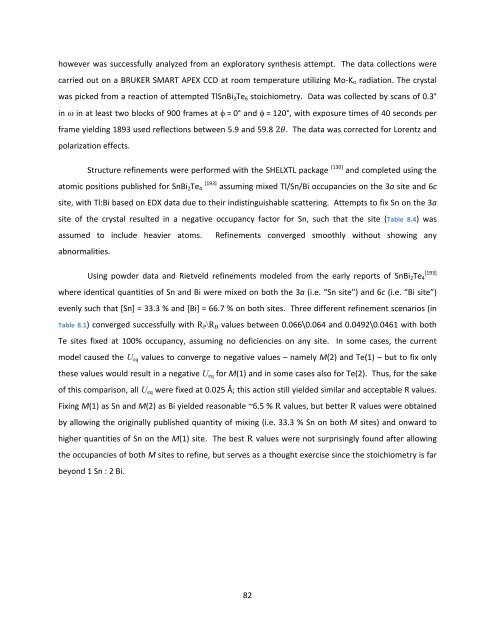Exploration and Optimization of Tellurium‐Based Thermoelectrics
Exploration and Optimization of Tellurium‐Based Thermoelectrics
Exploration and Optimization of Tellurium‐Based Thermoelectrics
You also want an ePaper? Increase the reach of your titles
YUMPU automatically turns print PDFs into web optimized ePapers that Google loves.
however was successfully analyzed from an exploratory synthesis attempt. The data collections were<br />
carried out on a BRUKER SMART APEX CCD at room temperature utilizing Mo‐Kα radiation. The crystal<br />
was picked from a reaction <strong>of</strong> attempted TlSnBi3Te6 stoichiometry. Data was collected by scans <strong>of</strong> 0.3°<br />
in in at least two blocks <strong>of</strong> 900 frames at = 0° <strong>and</strong> = 120°, with exposure times <strong>of</strong> 40 seconds per<br />
frame yielding 1893 used reflections between 5.9 <strong>and</strong> 59.8 2. The data was corrected for Lorentz <strong>and</strong><br />
polarization effects.<br />
Structure refinements were performed with the SHELXTL package [130] <strong>and</strong> completed using the<br />
atomic positions published for SnBi2Te4 [193] assuming mixed Tl/Sn/Bi occupancies on the 3a site <strong>and</strong> 6c<br />
site, with Tl:Bi based on EDX data due to their indistinguishable scattering. Attempts to fix Sn on the 3a<br />
site <strong>of</strong> the crystal resulted in a negative occupancy factor for Sn, such that the site (Table 8.4) was<br />
assumed to include heavier atoms. Refinements converged smoothly without showing any<br />
abnormalities.<br />
Using powder data <strong>and</strong> Rietveld refinements modeled from the early reports <strong>of</strong> SnBi2Te4 [193]<br />
where identical quantities <strong>of</strong> Sn <strong>and</strong> Bi were mixed on both the 3a (i.e. “Sn site”) <strong>and</strong> 6c (i.e. “Bi site”)<br />
evenly such that [Sn] = 33.3 % <strong>and</strong> [Bi] = 66.7 % on both sites. Three different refinement scenarios (in<br />
Table 8.1) converged successfully with RP\RB values between 0.066\0.064 <strong>and</strong> 0.0492\0.0461 with both<br />
Te sites fixed at 100% occupancy, assuming no deficiencies on any site. In some cases, the current<br />
model caused the Ueq values to converge to negative values – namely M(2) <strong>and</strong> Te(1) – but to fix only<br />
these values would result in a negative Ueq for M(1) <strong>and</strong> in some cases also for Te(2). Thus, for the sake<br />
<strong>of</strong> this comparison, all Ueq were fixed at 0.025 Å; this action still yielded similar <strong>and</strong> acceptable R values.<br />
Fixing M(1) as Sn <strong>and</strong> M(2) as Bi yielded reasonable ~6.5 % R values, but better R values were obtained<br />
by allowing the originally published quantity <strong>of</strong> mixing (i.e. 33.3 % Sn on both M sites) <strong>and</strong> onward to<br />
higher quantities <strong>of</strong> Sn on the M(1) site. The best R values were not surprisingly found after allowing<br />
the occupancies <strong>of</strong> both M sites to refine, but serves as a thought exercise since the stoichiometry is far<br />
beyond 1 Sn : 2 Bi.<br />
82
















